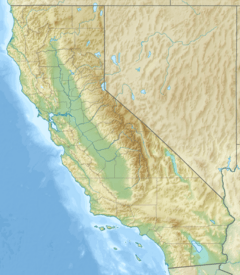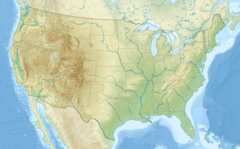Fine Gold Creek facts for kids
Quick facts for kids Fine Gold Creek |
|
|---|---|
|
Location in California
|
|
| Other name(s) | Fine Gold |
| Country | United States |
| State | California |
| County | Madera County |
| Physical characteristics | |
| Main source | Fine Gold Thornberry Mountain 37°15′46″N 119°37′22″W / 37.26285°N 119.62285°W |
| 2nd source | North Fork Fine Gold Thornberry Mountain 37°14′44″N 119°39′53″W / 37.24553°N 119.66472°W |
| 3rd source | Little Fine Gold Goat Mountain 37°16′30″N 119°33′35″W / 37.27513°N 119.55972°W |
| River mouth | Millerton Lake 191 metres (627 ft) 37°02′53″N 119°38′24″W / 37.0480048°N 119.6398644°W |
| Basin features | |
| Basin size | 90 square miles (23,000 ha) |
| Tributaries |
|
Fine Gold Creek is a small river, also called a creek, located in Madera County, California. It flows into the San Joaquin River. The creek is about 18 miles (29 km) long. It gets its name from the gold mining that used to happen in the area. Many places in California, like nearby Coarse Gold Gulch, were named this way.
Contents
The Creek's Path and Branches
Fine Gold Creek starts high up on the south side of Thornberry Mountain. This is its "headwaters," or where it begins. From there, it flows generally southwest. The creek drops about 3,600 feet (1,100 meters) from its start to where it meets the San Joaquin River.
The mouth of Fine Gold Creek is near where Fort Miller once stood. This area is now covered by Millerton Lake.
Main Branches of Fine Gold Creek
Fine Gold Creek has two main branches that flow into it:
- Little Fine Gold Creek
- This branch starts on the west side of Goat Mountain.
- It flows for about 10 miles (16 km).
- North Fork Fine Gold Creek
- This branch is about 6 miles (10 km) long.
- It starts west of Thornberry Mountain.
Smaller Streams
Many smaller streams flow into Fine Gold Creek. Most of these are "ephemeral," meaning they dry up in the summer. The main creek bed often has long sandy sections. These connect to a few rocky pools that can be 1 to 2 meters deep in summer.
The total area that drains into Fine Gold Creek is about 90 square miles (230 square kilometers). This area is called its "drainage basin" or "watershed."
Nature and Wildlife
The area around Fine Gold Creek is mostly woodland foothills. You can find oak trees, digger pines, and willows. There are also grassy areas and "riparian habitats." Riparian means areas along a river or stream. These habitats have special plants like ash, poplar, willow, and buttonbush.
Plants and Animals in the Creek
Inside the streambed, you might see plants like rabbitfoot grass, monkeyflowers, sedges, and clover. Most of the fish in the creek are not native to the area. However, you can find native fish like the Sacramento sucker, hitch, and California roach.
Protecting the Environment
Some parts of the creek banks have been damaged by animals grazing. Also, local roads and the building of Millerton Lake have affected the creek. For example, fish like the green sunfish from Millerton Lake can now enter the creek. These changes have reduced the variety of living things, or "biodiversity," in the creek.
The entire area around the creek is important for protecting different types of water life. There are eight special plant species that live in the creek's watershed. Animals like the California tiger salamander, western spadefoot toad, and western pond turtle have also been seen there.
People and Transportation
The Fine Gold Creek watershed does not have many people living in it. There are roads that lead to farms and scattered single-family homes. Roads like Hidden Lake Boulevard and County Road 210 cross the creek. Near where the creek meets Millerton Lake, County Road 216 leads to small neighborhoods.
Native American History
The lower part of Fine Gold Creek is the traditional land of the Mono Native American people. The upper part belongs to the Chukchansi Yokuts. Other groups, like the Dalinchi Yokuts and Dumna Yokuts, also lived along parts of the creek and the San Joaquin River.
Discovering the Past
There are three known archaeological sites along Fine Gold Creek. These are places where scientists study the history of human life. One site even has an old two-story house.
Gold Mining History
Gold mining was an important activity in the Fine Gold Creek area. Diaries from the 1850s mention people mining there. One miner, N. H. Stockton, wrote that he sometimes found more than $30 worth of gold per day in 1850. This was a lot of money back then!
Fine Gold Creek also marked the border between two mining areas: the Hildreth Mining District and the Fresno Mining District.
Types of Mines
In 1894, a survey listed different types of gold mines in the area:
- Quartz mines: These mines dug into rock to find gold veins. Examples include the Bessie H. Mine and the Fine Gold Mine.
- Placer mines: These mines looked for gold flakes and nuggets in sand and gravel, often in riverbeds. Examples include the Achsah D. Mine and Little Willie's Mine.



